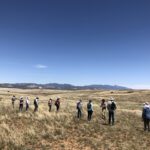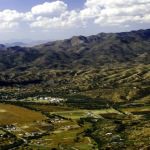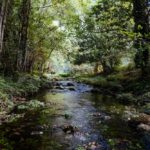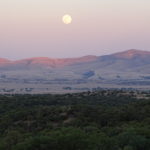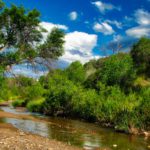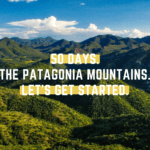
Oct 6, 2016 | Blog
Imagine a little-known national treasure — a largely wild land home to ocelots, exotic and imperiled birds like elegant trogons and Mexican spotted owls, imperiled reptiles and amphibians like the threatened Chiricuahua leopard frog, and El Jefe, the only jaguar currently living in the United States. This is the Mountain Empire of southern Arizona, a place as special as Yosemite or Yellowstone, and worthy of international recognition. Extending across the border into northern Sonora, Mexico, this region is bounded by mountains that rise from the flat desert floor to touch the sky. With one of the richest concentrations of biodiversity in the U.S., the Mountain Empire is a sanctuary for imperiled species. But even a sanctuary can be threatened.

Mountain Empire, © Thunderforest
Refuges in the Sky
One reason the Mountain Empire has so many rare and unique species is the rugged sky island mountain ranges. Each range, like the iconic Santa Rita Mountains, south of Tucson, stands alone surrounded by desert flatlands like an island in the sea, with mountains so tall that they span climate zones from hot, dry desert to moist forests at higher altitudes. Together, these characteristics give the mountains their nicknames of “sky islands.” For many species, the sky islands are refuges where human impacts have been relatively small. Streams rise from the rocks, nurturing rare fish, frogs, snakes, and nesting habitat for birds like threatened yellow-billed cuckoos, southwestern willow fly catchers and hummingbirds.
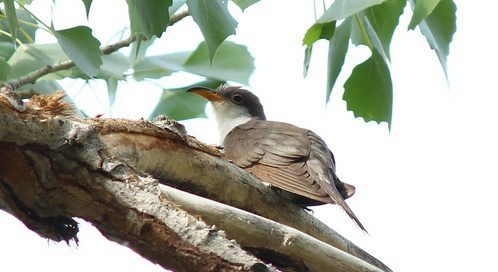
Western yellow-billed cuckoo, © Creed Clayton/USFWS
There are so many hummingbird species in the Mountain Empire that the Tucson Audubon Society founded the Paton Hummingbird Center, dedicated to conserving hummingbirds and other local biodiversity.
Birders visit from countries around the world for the chance to see so many species in one place. One of Defenders’ board members, Dr. Ron Pulliam, works with the Mountain Empire group Borderlands Restoration to restore the plants that hummingbirds, bees, butterflies, and moths need along Harshaw and Sonoita Creeks in the Patagonia Mountains. The globally imperiled Patagonia eyed silk moth, once widespread in native grasslands, is now making its last U.S. stand in the Patagonia Mountains. The threatened southwestern willow flycatcher, once common near Tucson in now-vanished gallery forest along the Santa Cruz River, is today found higher up in riparian vegetation along still-flowing mountain streams.
One of the gems of the Mountain Empire is the Las Cienegas National Conservation Area: 45,000 acres of rolling grasslands, oak-studded hills, along with the Cienegas Creek wetlands. This is home to the world’s largest population of endangered Gila topminnow and other federally threatened and endangered fish, frogs and snakes. Las Cienegas provides a vital corridor of protected lands that connects the Santa Rita and Whetstone sky islands.
The most revered animal in the Mountain Empire is El Jefe, a powerful male jaguar. Video of him prowling along a stream in the Santa Rita Mountains recently went viral, with at least 20 million viewers. He and other jaguars and ocelots most likely came north to the U.S. from Sonora, Mexico in the past decade, travelling along sky island mountain corridors with little human activity.
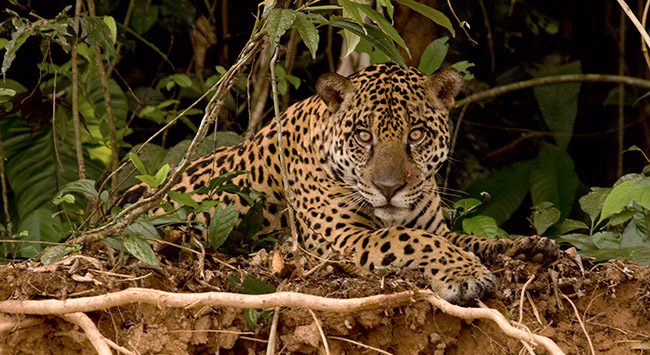
Jaguar, © Barry Draper
Threats to the Empire
Sadly, as much healthy habitat as there is in this region, there’s also a problem: Industrial mining. The Mountain Empire is riddled with old abandoned mines and grandiose plans for new ones. As you can imagine, mining has a massive impact on an ecosystem, from the land itself, to the noise that can scare wildlife away, to the traffic that would come in and out of the mining project. And perhaps most importantly, there’s the water.
Throughout the Southwest, so much groundwater has been pumped for agriculture, industry, and towns and cities that water tables have dropped and streams and ponds have dried up, desiccating wildlife habitat in a land already parched. This is why so many water-dependent species have vanished, or are threatened or endangered. In Arizona, 20 of 35 surviving native fish species are endangered and one is already extinct. Mining presents yet another threat to the water supply, using up billions of gallons of groundwater over the course of years, and often contaminating it with pollutants.
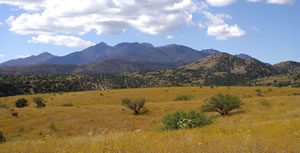
Santa Rita Mts, © Larry Jones/USFS
The diversity of the “sacred” Santa Rita Mountains in the Coronado National Forest is threatened by mining interests.
The giant open-pit Rosemont Mine is planned for the Mountain Empire’s Santa Rita Mountains, where it would destroy habitat that is home to El Jefe and endangered ocelots. It would also decrease the water for the topminnow and other species in the Las Cienegas wetlands.
Two other mines are planned for the Patagonia Mountains in the center of the Mountain Empire. A Canadian company (ironically called Arizona Mining) is planning the Hermosa mine, which means beautiful in Spanish. There is nothing beautiful about this proposed silver mine: If done by the most economical open-pit method, it would gash a huge 4,000 foot wide hole in the mountains and dump the waste rock on the ground. A recent study by Earthworks and the Patagonia Area Resource Alliance estimated that an open-pit mine here would take as much as 1.2 billion gallons of water per year from nearby streams and wells, harming wildlife as well as the local economy, which is based largely on ranching and tourism. Exploratory drilling (to prove the minerals are worth mining) is already taking place right next to Harshaw Creek, up against the protected activity center for a pair of threatened Mexican spotted owls and habitat for threatened yellow-billed cuckoos.
Thankfully, none of these projects are going unchallenged. Defenders and the Patagonia Area Resource Alliance (PARA) are currently reviewing and preparing formal federal comments on a proposal by Arizona Mining to expand exploratory drilling onto Forest Service land. Last year, Defenders and PARA also joined in a lawsuit that overturned the Forest Service’s illegal approval of plans by another mining company, Regal Resources, to drill exploration cores along Harshaw Creek.
The Mountain Empire is an irreplaceable landscape in the Southwest. Defenders will keep working with local activists to monitor toxic spills and stop illegal mining that would harm the jaguars, ocelots, and other rare species that make it their home.
 Rob Peters, Senior Representative, Southwest Office
Rob Peters, Senior Representative, Southwest Office
As a jack-of-all trades in the Tucson Office, Rob collaborates with the Defenders Renewable Energy Group, helping evaluate and influence renewable energy policies and projects to ensure that renewable energy is developed wisely, with minimum harm to natural ecosystems. He also works on jaguar issues, helping plan for the eventual return of a viable population in the U.S., and he is the lead on Defenders efforts to safeguard Arizona’s Mountain Empire, a Defenders’ priority area surrounding the town of Patagonia. This area contains some of the last best native grasslands in the Southwest, along with important habitat for jaguar, Mexican spotted owl, and other endangered species.
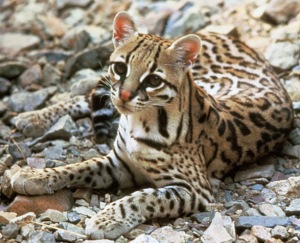
Aug 15, 2016 | Blog
FOR IMMEDIATE RELEASE
AUGUST 15, 2016

Ocelot, photo US FWS
TUCSON, Ariz. – The U.S. Fish and Wildlife Service released a recovery plan that will guide restoration and protection of the ocelot populations in Arizona and Texas and in bordering Mexican states of Sonora and Tamaulipas. The ultimate goal of the plan is to increase the number of ocelots in both nations, protect their habitat and create connecting habitat corridors between Arizona and Sonora and between Texas and Tamaulipas. This unique endangered cat ranges as far south as Argentina, but in the U.S. is found only in two small areas of Arizona and Texas.
Statement by Rob Peters, senior Southwest representative for Defenders of Wildlife
“It is encouraging to see a plan that sets quantitative targets for ocelot recovery – 1,200 animals in the Texas-Tamaulipas area and 1,000 in the Arizona-Sonora. To reach these targets, wildlife agencies must decrease deaths and increase important thorn scrub habitat, goals that will require funding and binational cooperation. A serious question is whether there is the political will to provide the necessary resources and limit development.
“Big threats to ocelot recovery in the U.S. include giant open-pit mines like the Rosemont and Hermosa proposed in ocelot habitat in Arizona. In south Texas, three huge liquefied natural gas export terminals are planned right next to the Atascosa National Wildlife Refuge. One terminal would sit on – and possibly sever – an ocelot travel corridor identified by the U.S. Fish and Wildlife Service as vital to the recovery of the ocelot population in Texas. This recovery plan is a starting point, but it will only succeed if harmful developments are stopped and sufficient resources are provided for key conservation actions. Defenders will vigilantly monitor proposed development activities that threaten the future of the ocelot in the United States.”
Background:
U.S. ocelot populations, once extending into Arkansas and Louisiana, have shrunk to a small patch of southern Texas, with perhaps 50 animals, and southern Arizona, where only five animals have been detected since 2009. Ocelots, found in every country south of the United States except Chile, are endangered throughout their range. Some 95 percent of the cats’ native habitat in the U.S. has become urbanized or has been converted to agriculture.
Listed under the Endangered Species Act in 1982 as endangered, the species was initially pushed to the brink of extinction due to habitat loss and overhunting. Now, collisions with vehicles and insufficient habitat are keeping ocelot population numbers in the U.S. low. Mines and liquefied natural gas plants are important new threats.
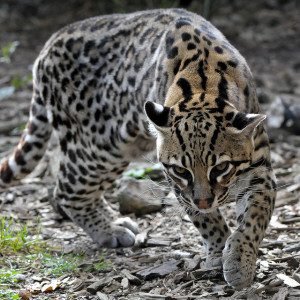
Sep 16, 2015 | Blog
FOR IMMEDIATE RELEASE
Contact: Courtney Sexton, csexton@defenders.org, 202-772-0253
Wendy Russell, wendy@patagoniaalliance.org, 520-477-2308
Federal court flips the off switch on Forest Service’s approval of “Sunnyside” project in Coronado National Forest
Tucson, Ariz. —A district court in Arizona put the brakes on an environmentally destructive exploratory drilling project in the Coronado National Forest near Patagonia, Arizona, saying the Forest Service failed to conduct the appropriate environmental review before fast-tracking the approval of the “Sunnyside” project. In October 2014 conservation groups Defenders of Wildlife and the Patagonia Area Resource Alliance (PARA) filed a lawsuit claiming the Forest Service’s approval violated environmental laws and posed a threat to endangered species in the area.
Statement from Rob Peters, Defenders of Wildlife:

Pictured: Ocelot by Steve Harris
“This is a great victory for the many species of imperiled wildlife that call the Coronado National Forest and the Mountain Empire region home, especially the jaguar, Mexican spotted owl, ocelot and yellow-billed cuckoo, all of which are already at risk from multiple projects in the region.
“The court’s ruling against this destructive mining operation is the best thing that could have happened for the residents of Patagonia and for the incredible and diverse wildlife in the area.”
Statement from Wendy Russell, Patagonia Area Resource Alliance:
“We’re not going to stand by and let the Forest Service rubber-stamp these mining projects in the Patagonia Mountains. There’s too much at stake for both our community and wildlife. This is the second time we’ve had to take them to court, and the second time we’ve won.”
Defenders and PARA were assisted in the case by Roger Flynn, an attorney with the Western Mining Action Project. Flynn noted the importance of local residents’ right to participate in the Forest Service’s review of mineral projects on public land – residents were excluded from this process in the fast-tracking of the approval, a violation of federal law.
Background:
The Canadian mining company Regal Resources’ Sunnyside Project (an exploratory mining operation) involves drilling six exploratory holes for copper deposits up to 6,500 feet deep roughly five miles from the town of Patagonia, Arizona. The Forest Service issued a “categorical exclusion” decision which essentially fast-tracked the mineral drilling exploration and approved the project without involving the public or taking a hard look at the project’s impacts to endangered species. The decision authorized Regal Resources to run its drill rigs for at least five months in sensitive endangered species’ habitat. Loud mineral drilling operations and construction would occur 24 hours a day, seven days a week (using artificial lighting at night) with total project operations and reclamation lasting up to three years.
In January of this year, the Forest Service temporarily withdrew approval for the Sunnyside project until it completed consultation with the U.S. Fish and Wildlife Service to determine whether the project would significantly affect the western yellow-billed cuckoo, which is listed as a federally threatened species. After completing the consultation and concluding that there would be no significant effects, the Forest Service re-issued its approval for drilling to proceed in April, 2015.
###
Defenders of Wildlife is dedicated to the protection of all native animals and plants in their natural communities. With more than 1.2 million members and activists, Defenders of Wildlife is a leading advocate for innovative solutions to safeguard our wildlife heritage for generations to come. For more information, visit www.defenders.org and follow us on Twitter @DefendersNews.
The Patagonia Area Resource Alliance is a citizen watchdog organization that monitors the activities of mining companies, as well as ensures government agencies’ due diligence, to make sure their actions have long-term, sustainable benefits to our public lands, our water, and the town of Patagonia. For more information visit www.patagoniaalliance.org and follow us on Twitter @PARAalliance.

Sep 9, 2015 | Blog
 The Patagonia Area Resource Alliance and Defenders of Wildlife were in federal court in Tucson last Thursday to present oral arguments against the Forest Service’s unlawful approval of a mining exploration project in the Patagonia Mountains on the Coronado National Forest.
The Patagonia Area Resource Alliance and Defenders of Wildlife were in federal court in Tucson last Thursday to present oral arguments against the Forest Service’s unlawful approval of a mining exploration project in the Patagonia Mountains on the Coronado National Forest.
Over 20 people attended the court hearing in support of PARA, Defenders of Wildlife and the Patagonia Mountains.
Canadian mining company Regal Resources’ Sunnyside Project involves drilling six exploratory holes for copper deposits up to 6,500 feet deep roughly five miles from the Town of Patagonia.
The Forest Service issued a “categorical exclusion” decision which essentially fast-tracked the mineral drilling exploration and approved the project without doing any environmental assessments. The decision authorized Regal Resources to run drilling for one year, with a seven month stoppage during the breeding seasons of the Mexican spotted owl and Yellow-billed cuckoo.
Defenders of Wildlife Lawyer Jay Tutchton argued that the Forest Service’s approval of the Sunnyside project violates environmental laws and poses a potential threat to local, endangered species. The extensive mineral drilling and construction would run 24 hours a day, seven days a week with total project operations and reclamation lasting up to 3 years.
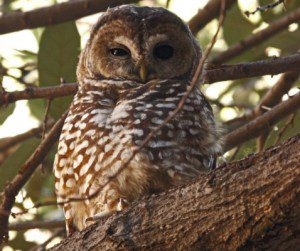
Mexican Spotted Owl ©Gooch Goodwin
The Patagonia Mountains support some of the world’s most threatened and endangered wildlife, including the jaguar, ocelot, lesser long-nosed bat, Mexican spotted owl, and yellow-billed cuckoo. Of particular concern is the Mexican spotted owl “Protected Activity Center” (PAC), prime habitat which is supposed to have the greatest protection by law and is occupied by the owls year-round. One of the project’s proposed drilling sites is less than 200 yards from a “nesting core area” of the PAC. The noise caused by the drills would be louder than a chainsaw and would disrupt about one-third of the Mexican spotted owls’ PAC, as well as the migratory corridors of jaguars and ocelots, Tutchton argued.
The Forest Service asked the court to dismiss the complaint. Forest Service lawyer Julia Thrower claimed the decision to grant a categorical exclusion complied with the National Environmental Protection Act and was not arbitrary or capricious.
“We’re optimistic that the judge will agree that the Forest Service’s attempt to avoid extra paperwork by skipping environmental assessments violates the law and places local, imperiled wildlife in even more jeopardy,” said Wendy Russell of the Patagonia Area Resource Alliance.
U.S. District Court Judge Rosemary Marquez said that she would take the matter under advisement and would issue her ruling before the proposed October 1 start date.
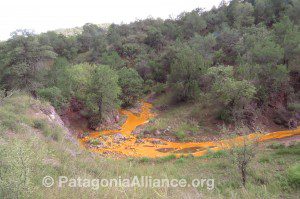
May 8, 2015 | Blog

Toxic overflow from the historic Lead Queen mine in the Patagonia Mountains drains towards Harshaw Creek.
The Coronado National Forest, Sierra Vista Ranger District hosted a community meeting in Patagonia, Arizona on April 28. The Lead Queen Mine cleanup plan was by presented by Floyd Gray of United States Geological Survey (USGS), and Eli Curiel of the Forest Service.
The Lead Queen was an underground mine for lead, silver, zinc, copper and gold that started in 1898 and was abandoned after 1940. After heavy rains in September 2014, members of PARA discovered and reported the leaking mine site, located approximately 6 miles south of Patagonia, Arizona. In December, the Arizona Department of Environmental Quality served the Forest Service with two notices of violation for the toxic mine spill. The Forest Service issued a “Time Critical Removal Action Approval Memorandum” in February to mitigate the spill and its potential threats to public health and welfare, water and wildlife. Clean up was scheduled to start Spring 2015, before monsoon rains could potentially wash contamination further downstream.
Floyd Gray gave an overview of his findings from sampling and testing the water, soil, and waste rock around the abandoned mine site. It was also deduced that there is more than one source of leakage from the mine site. One source was identified by its extreme concentration of iron while the other source is high in aluminum. All of the tested samples came back with very high levels of contamination from hazardous heavy metals such as arsenic and lead. In one water sample, the heavy metal levels were 20 times higher than the allowable drinking water standards. It was also determined that the mine contamination traveled 9/10th of a mile downstream.
The studies at the Lead Queen site to determine all of the sources of contamination has lead to a larger, ongoing study of the watersheds in the Patagonia Mountains by USGS and the Forest Service.
Eli Curiel detailed the plans to plug the six abandoned tunnels and shafts of the Lead Queen mine site with polyurethane foam. The waste rock piles laced with toxic heavy metals will be consolidated into a new location above the watershed and capped with clean fill to prevent future contamination. The polluted sediment in the waterway will be removed with the aid of a series of eleven gabion walls across the drainage filled with zeolite to capture and hold the heavy metals. The clean up area comprises five acres on the Coronado National Forest in the Patagonia Mountains. The mine site will require ongoing monitoring and maintenance, essentially forever.
The cost to taxpayers has not yet been determined. The clean up project has not yet gone out to bid. It’s expected to take up to 120 days with work possibly starting this summer.
More information can be obtained from the Forest Service Project On-Scene Coordinator, Eli Curiel at 520-388-8413.
Regal Resources Sunnyside Mine Exploration

Mexican Spotted Owl ©Gooch Goodwin
At the public meeting, an update was given on Regal Resources’ Sunnyside mining exploration project in the Patagonia Mountains by Forest Service Geologist Mindy Vogel. Conspicuously absent from Vogel’s overview was the ongoing litigation between Defenders of Wildlife and PARA against the Forest Service and US Fish and Wildlife for the unlawful approval of this project.
For the present time, no work is allowed at the Sunnyside site between March 1 and Oct 1, 2015 because of nesting Mexican spotted owls and Yellow-billed cuckoos in the area, according to the Forest Service Decision Memo.
No questions were permitted during any of the presentations. Audience members were required to seek out Forest Service and USGS personnel after all presentations were complete to ask questions. It is a format that we find effectively prevents members of the community from getting all of their questions answered and learning the most information possible.
Wildcat Silver Hermosa Proposal
Forest Service geologist Margie DeRose gave an overview and an update of the expected timeline of the AZ Mining Inc (aka Wildcat Silver, AMI) Hermosa mining exploration proposal in the Patagonia Mountains on the Coronado National Forest. The final Environmental Assessment and draft decision is estimated for release in October 2015 – over a year past the original timeline. A 45 day public objection period will follow.
Meanwhile, AZ Mining Inc / Wildcat Silver board chairman Richard Warke is privately funding more mine exploration drilling on their privately owned land. AZ Mining Inc / Wildcat Silver is now claiming that deposits for lead, zinc and silver exist for an additional mine at the Hermosa project, referred to as Hermosa North West.

Apr 27, 2015 | Blog
New Decision Memorandum Issued for Sunnyside Mineral Drilling Project in Patagonia Mountains
 The Forest Service sent out a notice on April 10th that a new Decision Memo has been issued for the Regal Resources Sunnyside project, an exploratory mineral drilling proposal in the Humboldt Canyon and Alum Gulch areas of the Patagonia Mountains on the Coronado National Forest.
The Forest Service sent out a notice on April 10th that a new Decision Memo has been issued for the Regal Resources Sunnyside project, an exploratory mineral drilling proposal in the Humboldt Canyon and Alum Gulch areas of the Patagonia Mountains on the Coronado National Forest.
The emailed notice from the Forest Service stated that exploratory drilling can start once “the operator provides a reclamation performance bond, incorporates the design features from the decision document, and the Plan of Operations is approved.”
The notice is misleading because it fails to mention two important facts.
No drilling can take place between March 1 to September 30 to avoid potential disturbance to the Mexican spotted owl and Yellow-billed cuckoo during their breeding season, as stated in the Decision Memo.
Additionally, PARA and Defenders of Wildlife are still in litigation against the Forest Service and US Fish and Wildlife Service for this unlawful approval of the Sunnyside Proposal. Read more…
The Sunnyside mineral drilling proposal is located approximately 7 miles south of the town of Patagonia. For more information concerning this decision, please contact Mindy Sue Vogel, Geologist, Coronado National Forest, 300 W. Congress Street, Tucson, AZ 85701, 520-388-8327, msvogel@fs.fed.us.

Apr 13, 2015 | Blog
FOR IMMEDIATE RELEASE
Kevin Pakulis Band to play benefit concert for Friends of the Mountain Empire, with special guest appearance from Congressman Raúl Grijalva
TUCSON, ARIZ. — The Kevin Pakulis Band will play a benefit concert to raise funds and awareness for the Friends of the Mountain Empire on Saturday, May 9th at the Hotel Congress in Tucson. Tickets for the magical evening of music can be purchased now to support the organizations – Patagonia Area Resource Alliance, Sky Island Alliance, Defenders of Wildlife, Tucson Audubon Society, Center for Biological Diversity and Save the Scenic Santa Ritas – that are working to protect and preserve the habitat, water, and wildlife of the Mountain Empire from new mining in the Patagonia Mountains, Santa Rita Mountains, Canelo Hills, and the San Rafael Valley of southern Arizona.

The event will provide a unique and exciting opportunity to hear the soulful music of Tucson-based, award-winning Americana singer-songwriter Kevin Pakulis, while supporting the incredible ecological and cultural biodiversity of the region.
“Our goal is to draw attention to the local organizations that play a vital role in protecting and restoring wild places in southern Arizona. More specifically, to draw attention to the message they bring – a message that deserves careful consideration, if not enthusiastic action,” said Pakulis.

Ocelot, photo US FWS
Arizona’s southwestern Mountain Empire is a hidden gem of the country, recognized for its beauty, uniqueness and ecological importance. The region is rich in wildlife and plant diversity and supports some of the world’s most imperiled wildlife including the jaguar, ocelot, lesser long-nosed bat, Mexican spotted owl and yellow-billed cuckoo. Sadly, destructive mining projects that continue to be proposed and approved threaten not only endangered wildlife, but the water, health and safety of local communities.
The benefit will include a special guest appearance from Congressman Raúl Grijalva, who will speak to the importance of conserving the natural and local communities of the Mountain Empire in the face of such threats.
About the Event
When: Saturday, May 9th, 7:00pm – 11:00pm
Where: Copper Hall in Hotel Congress, 311 E Congress St, Tucson, AZ 85701
Who: Kevin Pakulis Band, Friends of the Mountain Empire, Congressman Raúl Grijalva
Tickets: $20 Advance/$25 At the door
For more information and to purchase advance tickets, please visit: http://www.patagoniaalliance.org/friends-of-the-mountain-empire-benefit-concert-with-kevin-pakulis/
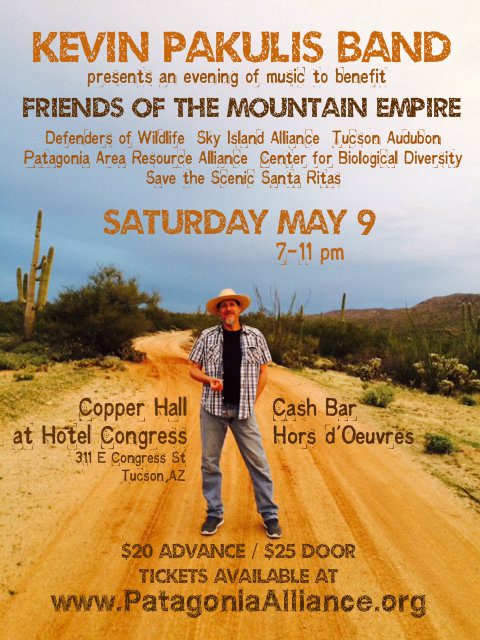
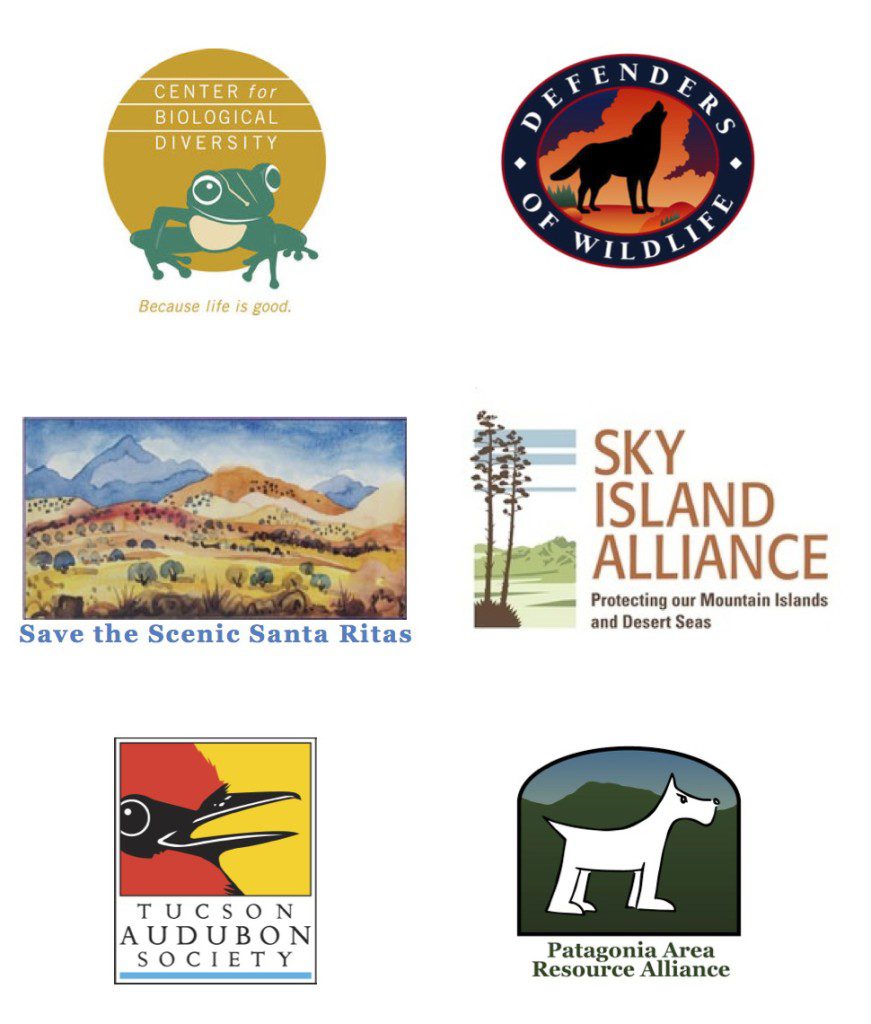

Apr 10, 2015 | Blog
|
|
|
Patagonia EARTHfest Event:
Trails Day • Earth Day • Arbor Day
A celebration of our biological diversity, cultural heritage, and local resiliency in Patagonia, Arizona.
The 6th Annual Patagonia EARTHfest is being held  on Saturday, April 18 in Patagonia, Arizona. Two additional feature presentations on Thursday, April 16 and Friday, April 17. on Saturday, April 18 in Patagonia, Arizona. Two additional feature presentations on Thursday, April 16 and Friday, April 17.
This year’s event theme is TREES.
The Patagonia Area Resource Alliance will be hosting a booth at Cady Hall for all the latest information on area mining (in)activity.
Follow link for full schedule of EARTHfest Guided Walks • Workshops • Youth Activities • Family Fun
Or follow the EARTHfest Facebook Page: facebook.com/EarthFestPatagoniaAZ |
|
|
Save the Date: Saturday, May 9, 2015
|

|
|
Kevin Pakulis Benefit Concert for Friends of the Mountain Empire
Join us for a very special evening of music with the Kevin Pakulis Band on Saturday, May 9 at 7pm in Copper Hall at Hotel Congress, Tucson.
Special guest appearance by Congressman Raúl Grijalva.
Support the organizations working to protect and preserve the habitat, water, and wildlife of the Mountain Empire from new mining in the Patagonia Mountains, Santa Rita Mountains, Canelo Hills and the San Rafael Valley of southern Arizona.
Center for Biological Diversity | Defenders of Wildlife | Save the Scenic Santa Ritas | Sky Island Alliance | Tucson Audubon Society | Patagonia Area Resource Alliance.
Additional thanks to Hotel Congress for helping us host an evening of information, inspiration, and MUSIC in their beautiful Copper Hall. |
|
|
|
|
|
|
|
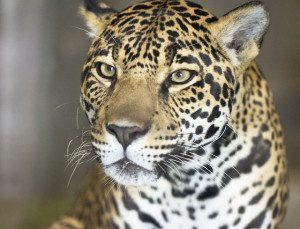
Jan 13, 2015 | Blog
FOR IMMEDIATE RELEASE
Plug Pulled on Proposed “Sunnyside” project in Arizona’s Coronado National Forest
Tucson, Ariz. — Today the U.S. Forest Service temporarily put the brakes on an environmentally hazardous mining project in southern Arizona’s Coronado National Forest that it previously approved in August. The Forest Service’s decision follows a similar move by the U.S. Fish and Wildlife Service, which had originally given the project the green light in August and then withdrew its approval in December. The agency decisions to withdraw their approvals of the Canadian mining company Regal Resources’ “Sunnyside Project” are based on the project’s potential violation of multiple environmental laws.

photo by Nathan Rupert
“The agencies knew from the beginning that this project could have a devastating impact on the local wildlife and habitat in this unique corner of the country,” said Rob Peters of Defenders of Wildlife. “The Coronado is home to an incredible diversity of imperiled species like the jaguar, ocelot and yellow-billed cuckoo, all which are already at risk from multiple projects in the region.”
“No one understood why they approved this project to begin with, but for the sake of Patagonia’s residents and wildlife, we are glad to see that they’ve reconsidered,” added Peters.
In October conservation groups Defenders of Wildlife and the Patagonia Area Resource Alliance filed a lawsuit claiming the federal agencies’ approvals the Sunnyside project violated environmental laws and posed a threat to endangered species and the safety of drinking water for local residents.
“Sunnyside could have been a disaster not only for our region’s unique wildlife, but also for the residents living directly downstream and the municipal watershed of the town of Patagonia,” said Wendy Russell of the Patagonia Area Resource Alliance. “Projects like Sunnyside use and abuse a tremendous amount of the local water supply and create long-term destruction of wildlife habitat. The people and wildlife of our national forests deserve more, and the agencies know that.”
Click to hear from environmental attorneys on why they sue.
###
Contact: Courtney Sexton, csexton@defenders.org, 202-772-0253
Wendy Russell, wendy@patagoniaalliance.org, 520-477-2308
Defenders of Wildlife is dedicated to the protection of all native animals and plants in their natural communities. With more than 1.1 million members and activists, Defenders of Wildlife is a leading advocate for innovative solutions to safeguard our wildlife heritage for generations to come. For more information, visit www.defenders.org and follow us on Twitter @DefendersNews.
The Patagonia Area Resource Alliance is a citizen watchdog organization that monitors the activities of mining companies, as well as ensures government agencies’ due diligence, to make sure their actions have long-term, sustainable benefits to our public lands, our water, and the town of Patagonia. For more information visit www.patagoniaalliance.org and follow us on Twitter @PARAalliance.
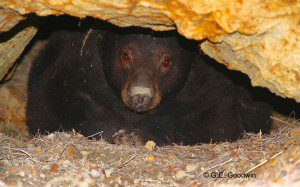
Dec 28, 2014 | Blog
The AZ Mining Inc (Wildcat Silver) Hermosa drilling project timeline was just pushed back–now almost a full year behind the previous schedule. We couldn’t have planned a better holiday gift! The release of the Hermosa Environmental Assessment (EA) and Draft Decision is now estimated for July 2015, which would then trigger a 45 day deadline for objections. If you commented on the Hermosa project, you will be able to participate in the objection process. PARA has successfully delayed AZ Mining Inc / Wildcat Silver–and all other mining companies–from drilling on public land in the Patagonia Mountains since 2011.
Your Gift is Helping to Save Wildlife and Water in Patagonia!

Save my home in the Patagonia Mountains. ©Gooch Goodwin
Billie the Black Bear makes her home in the Patagonia Mountains. Open pit mining would destroy her home and the water that we all depend upon. Your gift to the Patagonia Area Resource Alliance empowers us to keep new mining activity off of public land in the Patagonia Mountains–successfully since 2011!
Read more about our most recent Activities and Accomplishments.
Your donations also make it possible for us to organize community involvement and action so that we can protect the Patagonia Mountains, wildlife and habitats, our waterways and our communities.
Please consider making a donation to PARA this year to support and grow this critical work in the Patagonia Mountains: patagoniaalliance.org/donations/
A big thank you to everyone who has already donated this year!
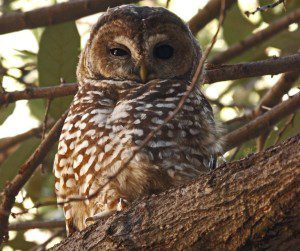
Mexican Spotted Owl © Glen E Goodwin
PARA Taking Action
The Forest Service approved the Sunnyside mineral drilling proposal by Regal Resources in the Patagonia Mountains, even though it directly threatens the imperiled Mexican spotted owl in the most sensitive area of their habitat–their roosting and nesting areas. As a result, we filed suit in federal court with Defenders of Wildlife for that unlawful approval, which violates environmental laws and poses potential threats to additional endangered species and the safety of drinking water for local residents.
Even More Good News: Thank You PARA Supporters!
We are very fortunate to have a group of amazingly committed community members and generous donors supporting our work.
We’ve just exceeded our year-end goal of raising $19,000! We on our way to reaching our entire 2015 operating budget. Thank you!
The work necessary to keep mining out of the Patagonia Mountains a reality is only possible because of your financial support.
Consider making an automatic, monthly donation to PARA on your credit card through PayPal.
Every single contribution makes a sizable difference to our organization and ultimately for our community.
It is only because of the generous support from people like you that we can undertake this critical work. Thank you!

Oct 29, 2014 | Blog
FOR IMMEDIATE RELEASE
October 29, 2014
Contact: Courtney Sexton, csexton@defenders.org, 202-772-0253
Wendy Russell, wendy@patagoniaalliance.org, 520-477-2308
Groups file complaint against Forest Service and Fish and Wildlife Service for approval of mineral drilling project in Arizona’s Coronado National Forest
TUCSON, ARIZ. – Defenders of Wildlife and the Patagonia Area Resource Alliance today asked a federal court to hold the United States Forest Service and United States Fish and Wildlife Service accountable for their unlawful approval of the “Sunnyside” mineral exploration drilling project in southern Arizona’s Coronado National Forest, in the Alum Gulch area of the Patagonia Mountains. The groups say the approval of the Canadian mining company Regal Resources’ Sunnyside Project violates environmental laws and poses a potential threat to endangered species and the safety of drinking water for local residents. The Sunnyside Project involves drilling multiple exploratory holes up to 6,500 feet deep in one of the most biologically diverse mountain ranges in Arizona. The extensive drilling and construction would run 24/7 for months on end, and the total project operations could last up to 3 years.

Mexican spotted owl, ©Gooch Goodwin
The Coronado National Forest, the Patagonia Mountains and the watersheds in this region support some of the world’s most imperiled wildlife, including the jaguar, ocelot, lesser long-nosed bat, Mexican spotted owl, and yellow-billed cuckoo. Of particular concern is the Mexican spotted owl “Protected Activity Center” (PAC) in the Alum Gulch area, a site which is supposed to have the greatest protection of the law. One of the project’s proposed drilling sites is only one-tenth of a mile from the “nesting core area” of this PAC.
“The potential damage from the Sunnyside Project, especially coupled with other damaging mining projects in the region, could have devastating impacts on this imperiled wildlife and the habitat they depend on, as well as the water supply for local residents,” said Rob Peters of Defenders of Wildlife. “This is a national forest and imperiled wildlife and their habitats on the forest should be protected— not polluted by expanded drilling operations.”

Ocelot, Leopardus pardalis. photo US FWS
Patagonia area residents are dependent on water originating from Alum Gulch, an area which is also designated as critical habitat for the jaguar and Mexican spotted owl. The imperiled ocelot, lesser long-nosed bat, and yellow-billed cuckoo have also been observed near the project area.
“The Sunnyside Project could have tremendous adverse impacts on local wildlife and local residents, affecting the floodplains and the municipal watershed of the town of Patagonia,” said Wendy Russell of the Patagonia Area Resource Alliance. “The drilling will require 12,500 gallons of water per day, an amount approximately equal to ten percent of the daily water usage of the Town of Patagonia. This project threatens not only endangered wildlife, but our community’s water, health and safety.”
Click to hear from environmental attorneys on why they sue.
###
Defenders of Wildlife is dedicated to the protection of all native animals and plants in their natural communities. With more than 1.1 million members and activists, Defenders of Wildlife is a leading advocate for innovative solutions to safeguard our wildlife heritage for generations to come. For more information, visit www.defenders.org and follow us on Twitter @DefendersNews.
The Patagonia Area Resource Alliance is a citizen watchdog organization that monitors the activities of mining companies, as well as ensures government agencies’ due diligence, to make sure their actions have long-term, sustainable benefits to our public lands, our water, and the town of Patagonia. For more information visit www.patagoniaalliance.org and follow us on Twitter @PARAalliance.
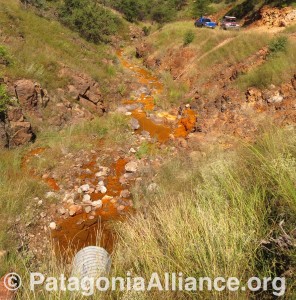
Sep 26, 2014 | Blog
FOR IMMEDIATE RELEASE
Contact: Courtney Sexton, 202.772.0253, csexton@defenders.org
Wendy Russell, 520.477.2308, Wendy@PatagoniaAlliance.org
Toxic Mining Contaminants Threaten People and Wildlife in Arizona

Bright orange water overflowing from the historic Trench mine, twice reclaimed by Asarco and now owned by the State of Arizona.
TUCSON, ARIZ. – Contaminants from a mine spill in Cananea, Sonora earlier this summer have likely reached the San Pedro River flowing into Arizona. And with recent storms, old copper and silver mine sites near Patagonia are leaking bright red contaminants into local streams. These toxic reminders of our mining history have the potential to wreak havoc on local water supplies and wildlife in the Coronado National Forest, one of the most biologically diverse areas in the world.
“The Coronado National Forest, the “Sacred” Santa Ritas, the San Pedro River Valley, the Patagonias and all of the Sky Islands nourish some of the most incredible and endangered biodiversity in the world, including jaguars, ocelots, yellow-billed cuckoos and Gila topminnows,” said Eva Sargent, director of Southwest Programs for Defenders of Wildlife. “This is a place that must be conserved, not a place for the destructive practice of mining and its toxic byproducts that ruin our public landscapes and pollute our waters.”

Toxic overflow from the historic Lead Queen mine in the Patagonia Mountains drains towards Harshaw Creek.
“All this toxic runoff is a prime example of why new mines should not be approved in the mountains of southern Arizona,” added Wendy Russell of the Patagonia Area Resource Alliance. “There are already approximately 130 abandoned mines in the Patagonia Mountains, many with eroding tailings and leaking tunnels discharging toxins. With heavy rainfall, that toxic discharge overflows into water systems like Harshaw Creek and Alum Gulch in the Santa Cruz watershed and threatens both local communities’ drinking water and already endangered fish and wildlife. With the state and federal governments seemingly incapable of cleaning up old polluting mines in the Patagonia Mountains, we have no confidence in their abilities to regulate new mining activity to protect our community’s drinking water, health and safety.”
Interviews with local experts regarding abandoned mine overflows in the Patagonia Mountains of southern Arizona in September, 2014.
###
Defenders of Wildlife is dedicated to the protection of all native animals and plants in their natural communities. With more than 1.1 million members and activists, Defenders of Wildlife is a leading advocate for innovative solutions to safeguard our wildlife heritage for generations to come. For more information, visit www.defenders.org<http://www.defenders.org/> and follow us on Twitter @DefendersNews<http://twitter.com/DefendersNews>.
The Patagonia Area Resource Alliance is a citizen watchdog organization that monitors the activities of mining companies, as well as ensures government agencies’ due diligence, to make sure their actions have long-term, sustainable benefits to our public lands, our water, and the town of Patagonia. For more information visit www.patagoniaalliance.org<http://www.patagoniaalliance.org>

Apr 25, 2014 | Blog

Apr 15, 2013 | Blog
With permission, we’ve reprinted Matt Clark’s Blog from Defenders of Wildlife regarding the TrekWest journey.
Matt Clark, Southwest Representative

Patagonia Mountains – rich habitat for wildlife in the southwest ©Matt Clark
If you are anything like me, you might get to feeling pessimistic sometimes because of all of the alarming news we hear about the growing extinction crisis, climate change and a plethora of other wildlife woes. The renowned conservationist Aldo Leopold once wrote, “One of the penalties of an ecological education is that one lives alone in a world of wounds. Much of the damage inflicted on land is quite invisible to laymen. An ecologist must either harden his shell and make believe that the consequences of science are none of his business, or he must be the doctor who sees the marks of death in a community that believes itself well and does not want to be told otherwise.” Since Leopold’s day, science has deepened our understanding of these ecological wounds and their consequences for wildlife – and has also revealed promising solutions.
Though most understand the damage done when a species’ habitat is destroyed, we often overlook the damage that comes from breaking the habitat into smaller pieces or crisscrossing it with roads and other barriers. When native habitats become too small, isolated and fragmented, they can’t support healthy wildlife populations.
Here in Defenders’ Southwest office, we’ve partnered with the Wildlands Network and a dozen or more of North America’s most respected conservation organizations to protect, connect and restore a contiguous network of lands along the spine of the Rocky Mountains and associated ranges, basins, plateaus, and deserts – all the way from Alaska’s Brooks Range to the Mexican Sierra Madre Occidental in Mexico. These habitats need to be stitched back together so that wildlife can survive in a crowded world, and can shift their ranges as climate change rapidly alters the environment.

A family of wild pigs trapped at the border fence that cuts across their habitat (©Matt Clark)
To bring attention to wildlife corridor conservation, outdoor adventurer John Davis is biking, hiking and paddling along a 5,000-mile journey from Mexico to Canada, highlighting the need for wildlife habitat and corridor protection on a local and international scale – a journey dubbed TrekWest. Along the way, John is pointing out projects by organizations, private landowners and decision-makers that have helped to protect or restore vital habitats and corridors. I joined John Davis and our local conservation partners on the trail for the second regional leg of his continental journey. We guided John to important places in the Sky Islands Ecoregion – one of Defenders’ focal landscapes – to highlight promising projects that aim to maintain and restore habitat connectivity.
While TrekWest is mostly about highlighting solutions and successes, we were also compelled to show John some of the obstacles to wildlife in the Sky Islands. We brought John to see the antithesis of habitat connectivity: the 20-foot-tall border wall that Customs and Border Protection has constructed along vast swaths of the border with Mexico, straight through prime wildlife habitat. Defenders led the charge against this massive project at the time, but sadly the construction continued without public input and via the waiving of important laws. On previous trips to the border, I have witnessed the wall’s effects on wildlife. I photographed a family of javelina (wild pigs) cut off from the Mexican part of their range, and have seen deer and mountain lions similarly stymied. Some of the more rugged, north/south wildlife corridors that span the border do not yet have walls constructed across them, and we hope they will never be built.

Jaguars like these are just beginning to make their way back into Arizona – but disconnected habitats make it a challenge.
Another threat we could not sugar-coat for John is a number of mining proposals in the region. We visited the site of the proposed Rosemont Copper Mine in the Santa Rita Mountains, just south of Tucson. If this open pit mine proceeds despite strong local opposition and legal challenges, it would destroy and fragment habitat for a wide range of species, including the jaguar. We also brought John to the Patagonia Mountains (a crucial, cross-border mountain range) and showed him the site of the proposed “Wildcat” silver mine. If constructed, this would be the second largest silver mine in the world – and like Rosemont, it would destroy thousands of acres of habitat and sever its connections for many wildlife species including the endangered jaguar, ocelot, and lesser long-nosed bat and the threatened Mexican spotted owl. Defenders is working with partner organizations such as Sky Island Alliance and the Patagonia Area Resource Alliance to prevent this mine from becoming the newest ecological wound to the region.
On the positive side, I helped to guide John on a hike to tour a local wildlife linkage that connects the Santa Catalina Mountains to the Tortolita Mountains. The connection between these two habitats was severed by urban development and a heavily traveled state highway (SR 77). The Coalition for Sonoran Desert Protection, of which Defenders is an active member, has worked tirelessly with stakeholders to protect the threads of habitat that remain intact. The Coalition also helped convince the Regional Transportation Authority to build wildlife underpasses, and an ambitious overpass, to enable wildlife to pass safely across SR 77. Once built, these wildlife-dedicated structures will give deer, fox, coyote, bobcat, mountain lion and other wildlife a way to cross from one habitat to the next without putting themselves or drivers at risk.

The bridge over Davidson Canyon allows wildlife to cross under Interstate 10 (©Matt Clark)
Later, I met up with John and staff from Sky Island Alliance on a hike through Davidson Canyon, a crucial wildlife corridor that links the Rincon Mountains and Pima County’s Cienega Creek Natural Preserve with the Santa Rita Mountains. The canyon is particularly important because the highway’s bridge gives wildlife a place to safely cross beneath Interstate 10. We documented many tracks near the bridge left behind by roadrunner, opossum, fox, coyote, bobcat and cougar. Black bear have also been documented utilizing this corridor. Sky Island Alliance is working with the transportation department and the county to ensure that this corridor remains functional for the free-flow of wildlife movement. These are but a couple of shining examples of how we are collectively working together to ensure wildlife has room to roam.
I believe that the most important factor that has changed since Aldo Leopold’s time is that we are no longer alone as we face these ecological challenges. We are a part of a strong and growing network of well-informed, passionate people working together toward a common and noble cause: the conservation and restoration of our natural heritage. For me, connectivity conservation fuels the flame of hope. It is a way we can give wildlife a fighting chance to survive in an increasingly fragmented and warming world.

Apr 7, 2013 | Blog
With permission, we’ve re-posted John Davis’s Blog from the Wildland’s Network TrekWest Journey.
John’s Blog from TrekWest
Posted on Apr 2, 2013
With Patagonia Area Resource Alliance, Sky Island Alliance and Defenders of Wildlife, Early March

“A veteran fence-cutter myself (always legally, of course, removing old barbed wire from various wild way lands where I work back East), I could almost feel the sense of liberation as Sergio described taking the fence out of a wildlife corridor…”
Lobo stood with us symbolically atop American Peak as we gazed worriedly down on the proposed site of the Wildcat Silver Mine (below right). Lobo is a promise, an artistic expression of hope crafted by a Zuni sculptor. This small figurine and others (including jaguar and ocelot, which are also both native to southern Arizona but jeopardized by roads and the border wall) we bear with us on this wild walk-about. The proposed Wildcat Silver Mine is a curse visited upon the good wildlife and people of the Patagonia Mountains and surrounds. If the Wildcat Silver Mine plans are approved, the Southwest will lose a critical wildlife corridor, vibrant waters, and scenery to live for.
Patagonia Area Resource Alliance (PARA) and kindred groups aim to prevent this theft. Together with Defenders of Wildlife, Sky Island Alliance, and others, PARA is organizing local and state residents to oppose this mine. Please help them.
Our day was not all about threats and alarms, though. PARA leaders showed me Madrean oak/pine woodlands primordial in their beauty, and talked with me also about their work on sustainability. This work includes pollinator advocacy led by naturalist and writer Gary Paul Nabhan, with whom I serve on the Board of Directors of Wild Farm Alliance http://wildfarmalliance.org. As Gary’s research has shown, southern Arizona is a continental leader in diversity of bees, ants, bats, hummingbirds, and other animal groups that include pollinators critical to both native and cultivated plants. The great diversity of pollinators in the Sky Islands owes to its topographic, geologic, and vegetative diversity.
So does the Madrean Archipelago’s exceptional diversity in mammals, about which Sergio Avila of Sky Island Alliance told us as we strode the Patagonias. From atop American Peak, Sergio pointed out how these mountains, modest in stature but immense in diversity, reach south into Mexico and how parallel ranges also provide key corridors for animals like jaguars and ocelots. Sergio noted that the Sky Islands is one of the few areas north of the tropics where one can find four native cats: bobcat, cougar, ocelot, and jaguar, all of which are wide-ranging and need big wild interconnected habitats.
Sergio also pointed to the border wall, cutting across the San Rafael Valley and into the mountains, threatening to sever the connections that keep these mountains so rich. Some of the rugged areas along the border thus far have been spared the building of impassable fencing; and it should be an international conservation priority to keep these wildlife corridors wall-free. Sergio had a bit of heartening news for all of us: He and other Sky Island Alliance folks had recently spent some time, at the request of the Bureau of Land Management, removing the barbed wire along the US/Mexico border where agencies deemed a simple vehicle barrier to be enough of a deterrent to drug traffickers. A veteran fence-cutter myself (always legally, of course, removing old barbed wire from various wildway lands where I work back East), I could almost feel the sense of liberation as Sergio described taking the fence out of a wildlife corridor.
TrekWest Action: Please don’t forget, to help fight these threats, you can go to trekwest.org and sign the petition to Say YES to protecting our Fast-Disappearing Wildlife Habitat Corridors, which we will deliver to decision-makers who can speed up this important conservation need. Also support the worthy organizations featured in this blog!
For the Wild,
John
Your kind consideration of a DONATION– all to help TrekWest inspire as many people as possible to support wildlife corridors and to keep up with basic supplies and equipment — is much appreciated.
Also, thank you SPONSORS!

Mar 12, 2013 | Blog
The Patagonia Area Resource Alliance is working to stop industrial mining in the Patagonia Mountains. We are very concerned about protecting and preserving the town’s water supply. Part of our mission also includes promoting the local tourism-based economy to our surrounding public lands and parks. The interesting thing that I’ve discovered while working for PARA is that our mission overlaps or complements the mission of many other organizations both local and national. Given that we’re on the Mexican border, I can say international organizations too! One of those organizations that complements our work is Wildlands Network.
John Davis with Wildlands Network is hiking the Western Wildway of the continent from Mexico to Alaska to promote awareness of the need for wildlife corridors. The Western Wildway is a 6,000-mile-long wildlife corridor that includes Mexico, the United States and Canada. According to their website, “protecting the Western Wildway represents North America’s best chance to ensure the survival of many threatened keystone species that require long-distance movement pathways, including grizzly bear, lynx, mountain lion, wolves, jaguars, and ocelots — all faced with growing pressure from development-based habitat fragmentation and climate disruption.” Learn more at www.trekwest.org
John Davis recently traveled through Patagonia, Arizona. PARA got the opportunity to show him the area in the Patagonia Mountains that is being threatened by Wildcat Silver’s proposed open pit mine. Accompanied by Matt Clark from the Southwest office of Defenders of Wildlife and Sergio Avila from Sky Island Alliance, we climbed American Peak in the Patagonia Mountains. We discussed how the wildlife corridor for jaguars, ocelots, bears and mountain lions through the Patagonia Mountains would essentially be blocked by the proposed Wildcat Silver mine. At the top of the peak, we could see into Mexico. The Patagonia Mountains are only one of two sky island mountain ranges that cross the border into Mexico. Sergio Avila quoted a study that showed that our bear population in the Patagonias is more closely related to bears in Mexico than they are in the nearby Santa Rita Mountains. The bird’s-eye view from the top further demonstrated the importance of the Patagonia Mountains as a wildlife corridor and the vast area of the mountains that would be impacted by Wildcat Silver’s proposed open pit mine, tailings piles, waste rock, tailings ponds and processing plants. Open pit mining operations and wildlife corridors cannot coexist.

Sergio Avila with John Davis on American Peak.
Photo ©Glen E Goodwin
We were thankful for the opportunity to bring our mission to stop mining in the Patagonia Mountains to the attention of an international organization with a complementary mission to keep North American wildlife corridors open. There are so many good reasons to keep open pit mining out of the Patagonia Mountains. Keeping vital wildlife corridors open is another one.
Wendy Russell
Jun 14, 2012 | Blog
Tombstone Arizona has made national headlines regarding its battle with the Forest Service over water rights. For 130 years pipelines have transported water from the Huachuaca Mountains 26 miles to Tombstone. The Monument Fire and subsequent mud slides last year destroyed this pipeline system. Tombstone has been trying to get emergency permission from the Sierra Vista District of the Coronado National Forest to bring in heavy equipment to repair the water system without success. The case has also gone to court, twice. Tombstone has lost both times.
Reasons given by the courts include the question of actual need and urgency of the repairs. Also in question is Tombstone’s entitlement to the water in the national forest. Tombstone claims rights to 25 springs while the Forest Service says they have permits for only 5. The federal government said none of that gives the city unfettered right of access. The Forest Service has also cited the Wilderness Protection Act as a reason for their reluctance to allow the requested repair of the pipeline. Machinery of any kind is banned in a Wilderness Area where the pipeline is located.
Another reason given was the presence of Mexican spotted owls. The owls are a threatened species. Supposedly, their presence is the big reason that the Forest Service wouldn’t grant Tombstone a permit to use heavy equipment to fix the pipeline. I have a hard time believing that one.
Here in the Patagonia Mountains we are lucky to still have Mexican spotted owls. Last year, the Sierra Vista District of the Coronado National Forest granted permission to Arizona Minerals aka Wildcat Silver to start exploratory drilling operations within Mexican spotted owl habitat. This drilling project would have operated 24 hours a day, 7 days a week, for 300 consecutive days. Along with noise and light disturbance there was the extremely high likelihood of destruction of owl habitat. Even the presence of a nearby federally-designated Mexican spotted owl Protected Activity Center didn’t block the approval of the drilling project. We, along with the Defenders of Wildlife and Sky Island Alliance had to sue the Forest Service to stop the drilling project.
It’s not just about the owls. The bigger question is how does the exact same Forest Service office come up with completely opposite policy actions?
U.S. high court denies Tombstone water relief
Sierra Vista Herald Sat, 06/02/2012
Tombstone readies picks and shovels
Sierra Vista Herald 06/07/2012
Spotted owl could be game-changer in Tombstone water war
CNN 06/09/2012
Dec 22, 2011 | Blog
FOR IMMEDIATE RELEASE
Hardshell exploratory drilling threatens endangered wildlife on Coronado National Forest
Conservation groups challenge project
TUCSON, Ariz.—A coalition of conservation groups has gone to court seeking a timeout on construction of the Hardshell Project on the Coronado National Forest in southern Arizona today. The groups are challenging the U.S. Forest Service for approving exploratory mineral drilling for a planned 3,000-acre mine without required studies of how it will impact endangered wildlife and the environment.
“The Forest Service appears to have pulled a fast one on this project by approving it without first assessing its environmental impact. There’s no way to expand industrial mining activities here without causing irreversible damage to wildlife,” said Craig Miller, Defenders of Wildlife’s Southwest representative. “When you take a broad view of all the industrial mining projects the Forest Service is allowing in this area, it’s alarming that it’s being done without considering impacts on our wildlife and wild places. It’s especially serious for endangered animals like the jaguar, whose survival depends on land managers ensuring that a few wild places like the Patagonia Mountains remain intact.”
The Hardshell Project site threatens habitat for endangered Mexican spotted owls, lesser long-nosed bats, and could cut off key migration corridors for ocelots and jaguars. Yet, the ForestService approved the project after waiving the need for analyzing its environmental impact based upon groundless assumption that the drilling would have no significant environmental effects.
“The Coronado National Forest is located within the heart of the Sky Island region, one of the most ecologically diverse spots in the world,” said Jenny Neeley, conservation policy director for Sky Island Alliance. “This project will likely degrade important wildlife habitat and disrupt a critical movement corridor for the jaguar and ocelot, which are known to roam this area. The ForestService is responsible for sustaining the unique biodiversity of this region, and as part of this responsibility it is required to take a hard look at the long-term impacts of this project before allowing it to move forward.”
The groups are asking the courts to put the project on hold until the Forest Service undertakes a thorough environmental review of its impacts.
“We want the Forest Service to give this proposed drilling project the serious consideration it is due,” said Wendy Russell with the Patagonia Area Resource Alliance. “A large part of our economy depends on tourism to these wild places. More important, the project is sited along Harshaw Creek, a major source of water for the town of Patagonia. We hope the court recognizes the importance of putting this project on hold until theForest Service does the proper analysis.”
Link to Complaint
###
Contacts:
James Navarro, Defenders of Wildlife, (202) 772-0247; jnavarro@defenders.org
Jenny Neeley, Sky Island Alliance, (520) 624-7080 x13; Jenny@skyislandalliance.org
Defenders of Wildlife is dedicated to the protection of all native animals and plants in their natural communities. With more than 1 million members and activists, Defenders of Wildlife is a leading advocate for innovative solutions to safeguard our wildlife heritage for generations to come. For more information, visit www.defenders.org.
Sky Island Alliance is a grassroots non-profit organization dedicated to the protection and restoration of the rich natural heritage of native species and habitats in the Sky Island region of the southwestern United States and northwestern Mexico. For 20 years, SIA has worked with volunteers, scientists, landowners, public officials, and government agencies to establish protected areas, restore healthy landscapes, and promote public appreciation of the region’s unique biological diversity.
The Patagonia Area Resource Alliance is an unincorporated association of volunteer community members dedicated to protecting and preserving the Patagonia, Arizona area. PARA is a watchdog organization that monitors the activities of industrial developers such as mining corporations, as well as government agencies, to make sure their actions have long- term, sustainable benefits to our public lands, our watershed, and our town. PARA is also committed to outreach and education within our community on the potential negative impacts hard rock mining could have on our surrounding ecosystems and to our growing eco-tourism based economy.





 Rob Peters, Senior Representative, Southwest Office
Rob Peters, Senior Representative, Southwest Office



































